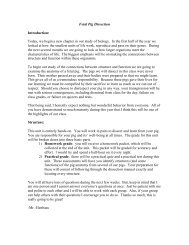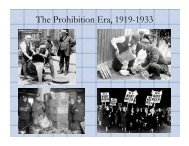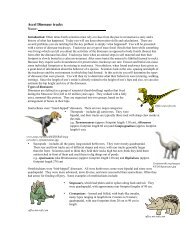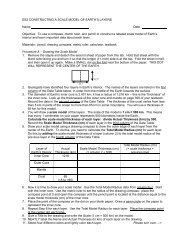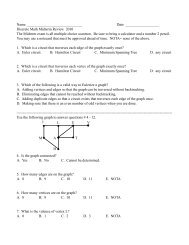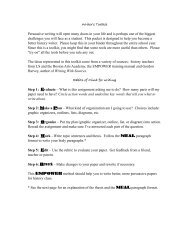INCOMPLETE DOMINANCE and CODOMINANCE - LS Home Page
INCOMPLETE DOMINANCE and CODOMINANCE - LS Home Page
INCOMPLETE DOMINANCE and CODOMINANCE - LS Home Page
You also want an ePaper? Increase the reach of your titles
YUMPU automatically turns print PDFs into web optimized ePapers that Google loves.
<strong>INCOMPLETE</strong> <strong>DOMINANCE</strong> Name:<br />
<strong>and</strong> CO<strong>DOMINANCE</strong><br />
Reading: CMR p.168-169<br />
Incomplete Dominance<br />
Previously you have studied genes in which one allele (one copy of a gene) was dominant <strong>and</strong> the<br />
other recessive. For instance, a heterozygous individual whose genotype is Hh, where “H” = right<br />
h<strong>and</strong>edness <strong>and</strong> “h” = left h<strong>and</strong>edness, would be right h<strong>and</strong>ed, since the right h<strong>and</strong>ed allele is<br />
dominant.<br />
There are some gene pairs in which neither allele is dominant, <strong>and</strong> when both alleles are present in<br />
the chromosomes both traits are expressed in the phenotype. The resulting heterozygote<br />
phenotype is typically in between the two different homozygote phenotypes. This pattern of<br />
inheritance is called incomplete dominance. Examples of this include petal coloration in some flower<br />
species, curlyness of human hair, <strong>and</strong> human hypercholesterolemia (see text for info on some of these).<br />
In the first example, snap dragons or carnations that are homozygous for a red petal allele are red,<br />
flowers which are homozygous for a white petal allele are white, <strong>and</strong> heterozygous flowers appear pink<br />
due to the lack of dominance between the red <strong>and</strong> white color alleles.<br />
In this case it is common to use two different capital letters of the alphabet to represent the red <strong>and</strong><br />
white alleles, such that: R = Red color<br />
W= White color<br />
In this example, red carnations would be RR, white carnations would be WW, <strong>and</strong> pink carnations<br />
would be RW. This is summarized below.<br />
Genotype Resulting Phenotype<br />
RR<br />
WW<br />
Red flowers<br />
White flowers if this were a dom/rec relationship<br />
RW Pink flowers (usually, what phenotype would you expect for this genotype? _______)<br />
Sample Problem #1<br />
a. A red carnation is crossed with a white carnation <strong>and</strong> the resulting offspring are all pink (indicating<br />
incomplete dominance). What would be the result of a cross between a pink <strong>and</strong> a white<br />
carnation?<br />
W<br />
Pink carnation genotype: RW White carnation genotype: WW<br />
R W Fill in the Punnett square <strong>and</strong> give the phenotype<br />
percentages of this cross:<br />
______ % are _________________ color<br />
W ______ % are _________________ color<br />
b. Could Red offspring be made from a cross of a White carnation with a Pink one? ____________<br />
(over for answers)<br />
Genetics page 1 Incomplete Dominance / Codominance
Sample Problem #1 Answers:<br />
a. Punnett square: R W<br />
W RW WW<br />
__50__ % are __White__ color<br />
W RW WW __50__ % are __Pink__ color<br />
b. Could Red offspring be made from a cross of a White with a Pink? _No, this is not possible_<br />
Sample Problem #2<br />
A curly haired person <strong>and</strong> a straight haired person mate <strong>and</strong> all their offspring have wavy hair (note<br />
that wavy hair is a phenotype in between that of the curly <strong>and</strong> straight haired individuals).<br />
What would be the result of a cross between two wavy haired individuals? (give phenotype %’s)<br />
Key: =<br />
Sample Problem #2 Answer:<br />
= The resulting F1 offspring would be:<br />
If C = curly hair<br />
S = straight hair<br />
C S<br />
F1: 25% Curly (CC)<br />
C CC CS<br />
50% Wavy (CS)<br />
25% Straight (SS)<br />
S CS SS<br />
Genetics page 2 Incomplete Dominance / Codominance
Codominance<br />
There is another pattern of inheritance that also is an example of lack of dominance. In this<br />
situation, if the resulting phenotype exhibits both traits of the parents, the offspring phenotype is said<br />
to be the result of codominance. Examples of this include A <strong>and</strong> B blood types in humans, sickle-cell<br />
disease, <strong>and</strong> coat color in cattle <strong>and</strong> horses.<br />
In this last example, cattle which are homozygous for a red coat allele are red, cattle which are<br />
homozygous for a white coat allele are white, <strong>and</strong> heterozygous cattle appear roan (red hairs mixed<br />
with white) due to codominance of the red <strong>and</strong> white coat color alleles. In this case it is common to<br />
use two different capital letters of the alphabet as superscripts to a common letter, to represent the red<br />
<strong>and</strong> white coat color alleles. For example, red cattle would be C R C R , white cattle would be C W C W , <strong>and</strong><br />
roan cattle would be C R C W , where:<br />
C R = red coat <strong>and</strong><br />
C W = white coat<br />
How is this different from red, white, <strong>and</strong> pink flowers?<br />
Cattle coat color would be considered incompletely dominant if C R C W were completely pink, instead<br />
of a patchy red <strong>and</strong> white.<br />
Carnation petal color would be considered codominant if RW were red <strong>and</strong> white striped, instead of<br />
solid pink.<br />
Nevertheless, both these patterns of inheritance are important for they deviate from the basic<br />
dominant/recessive pattern of inheritance.<br />
In summary: Cattle <strong>and</strong> Horse Coat Color<br />
Genotype Resulting Phenotype<br />
C R C R Red coat<br />
C W C W White coat<br />
C R C W Roan coat (red hairs mixed with white)<br />
Sample Problem #3 (answers on back)<br />
1. A roan bull (male) is mated with a white cow (female). What are the possible offspring?<br />
Bull’s genotype: Cow’s genotype:<br />
Punnett square: Fill in the Punnett square <strong>and</strong> give the phenotype<br />
percentages of this cross:<br />
______ % are _________________ color<br />
______ % are _________________ color<br />
2. Could Red offspring be born to a White cow mated with a Roan bull? ____________<br />
Genetics page 3 Incomplete Dominance / Codominance
Sample Problem Answers<br />
1. Punnett square:<br />
__50__ % are __White__ color<br />
__50__ % are __Roan__ color<br />
2. Could Red offspring be born to a White cow mated with a Roan bull? _No, this is not possible_<br />
Genetics page 4 Incomplete Dominance / Codominance



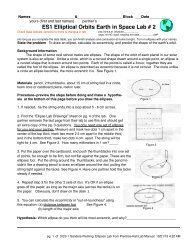


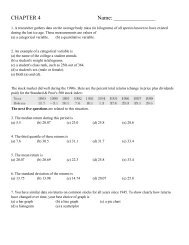


![';1asAu ro; las I sgeo8 leuo!]eslanuol aql utelqo o1 palenttouJ ue I ...](https://img.yumpu.com/49072782/1/190x221/1asau-ro-las-i-sgeo8-leuoeslanuol-aql-utelqo-o1-palenttouj-ue-i-.jpg?quality=85)

